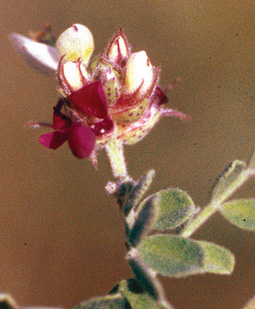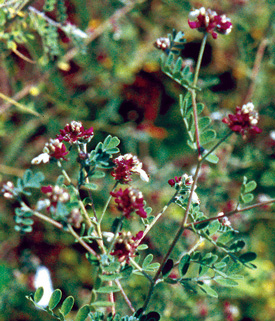Log: Dalea carthagenensis var. floridana
Sam Wright, Field Biologist (photos by the author)

Dalea carthagenensis var. floridana
“You're a biologist! WOW! That is so cool!” That was the response I got from future ecologist, eight-year-old Annegelica Bundy from Palm Bay. Annegelica, her mother, and I have been corresponding via email since she contacted Fairchild Tropical Garden last October. Annegelica needed assistance with the Uniola paniculata (sea oats) experiment she entered in her school science fair. She contacted us to find out where she could get sea oats plants to restore part of a dune near her home. She said in her email, “I love my beach, but people, mostly adults, do not take care of it. If we do not help our beach now, we will not have one,” After reading that, I realized that if we could do nothing more, at least we could point Annegelica in the right direction. I supplied appropriate contacts in her area and, from that, she gathered enough people to conduct a sea oat planting.
I guess being a field biologist is pretty cool. One of the job benefits is getting out into the field. While most people are stuck behind their computers in their compartmentalized worlds, I get to spend my days working on the endangered South Florida coastal dune ecosystem. On any given day, I may ehjoy a sunrise on the beach, the dive-bombing of pelicans, the unyielding stare of an osprey, or the fluttering of the endangered Eumaeus atala (atala) butterfly. Of course, the other half of my time is spent indoors in front of the mind-numbing computer, entering data, creating databases, responding to email, etc. Last fall, after spending more days in the office than I liked, I decided it was time to conduct a vegetation survey at one of our research areas on Key Biscayne.
It took a couple of hours to survey the coastal strand, which, in natural ecosystems, consists of open, sandy areas west of the stabilized dunes. The vegetation of this habitat includes low-growing plants such as Helianthus debilus (beach sunflower) and Bidens alba (beggar's tick), grasses such as Panicum amarum (bitter panic grass) and Uniola paniculata (sea oats), and woody species like Serenoa repens (saw palmetto), Sabal palmetto (sabal palm), Lantana involucrata (wild sage) and Coccoloba uvifera (seagrape).

Dalea carthagenensis var. floridana
During the survey I came up on a nondescript shrub that I had never seen before. It looked like a member of the Fabaceae family. Upon closer inspection, I noticed softly pubescent leaflets and stems with numerous red puncti (dots) on the underside of the leaves. Not knowing what the plant was, I decided to take a voucher (permit in hand) for further identification. The next day we were visited by Steve Woodmansee, one of our expert plant-identifying friends from The Institute for Regional Conservation (IRC). I showed him the specimen and his eyes lit up more than Ralphie's when he received his official Red Rider carbine action model air rifle on Christmas morning. Steve announced, “I think we have something here!”
We decided to confirm his suspicion and compare the specimen with those of the Garden's Research Center herbarium. It was official: our specimen was Dalea carthagenensis var. floridana, the critically imperiled (FNAl, IRC) Florida prairie clover. It turns out that D. carthagenensis var. floridana occurs on only two other sites in Miami-Dade County; there are fewer than 1,000 individual plants known. It was thought to be extirpated from all coastal sites and has not been seen on Key Biscayne in over 35 years (Gann et. al 2002).1 I'm happy to report that the population was doing very well, flowering and fruiting. I even noticed small juvenile plants, so we know that recruitment is taking place.
The managing agency of the property was notified and the Florida prairie clover population will be considered before any type of management (clearing, burning, etc.) is conducted in its vicinity. The population will continue to be monitored, and we hope we will have a chance to help increase its population and ensure the sustainability of this population.
With the hard work of individuals like Annegelica, some of the imperiled species like D. carthagensis var. floridana will have a chance. It turns out her project did not win the science fair but, as she put it,“I tried my best and still want to help my beach. The important winner is the beach.”
Yes, Annegelica I believe it is.
1. Gann, G. D., K. A. Bradley, and S. Woodmansee. 2002.
Rare Plants of South Florida: Their History, Conservation, and Restoration.
The Institute for Regional Conservation, Miami, Florida
Garden Views Spring 2003